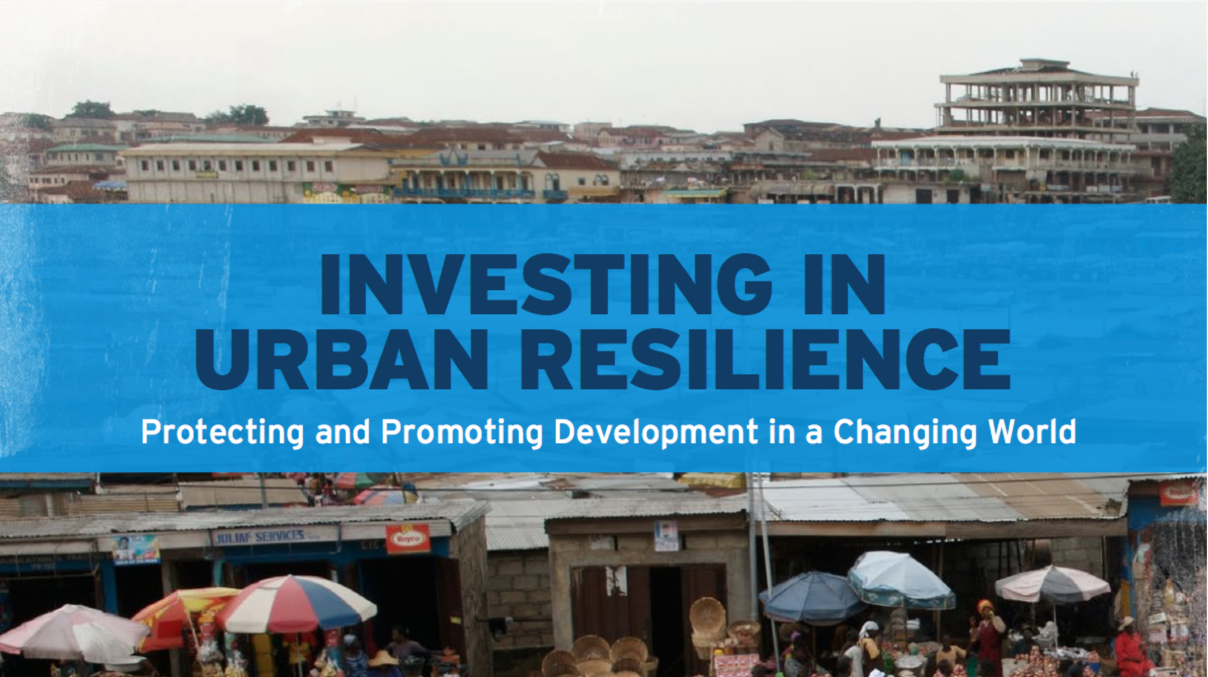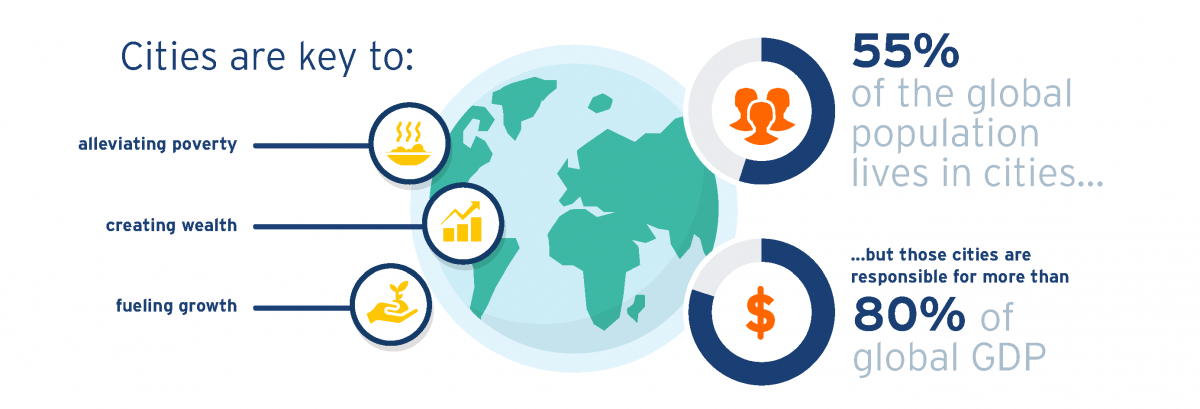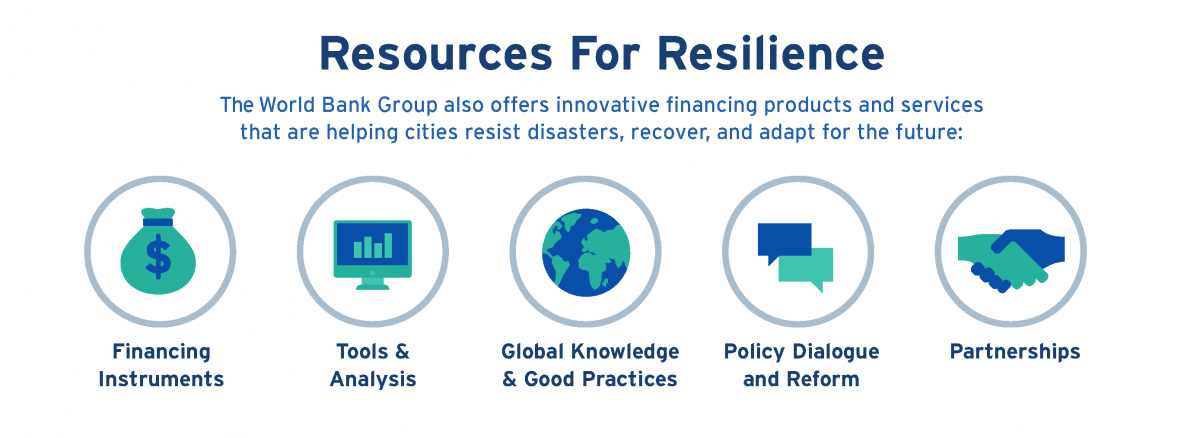
By 2030, without significant investment to improve the resilience of cities around the world, climate change may push up to 77 million urban residents into poverty.
Those are the findings of a new report by the World Bank and the Global Facility for Disaster Reduction and Recovery (GFDRR), released in advance of the United Nations Conference on Housing and Sustainable Urban Development (or Habitat III). Investing in Urban Resilience: Protecting and Promoting Development in a Changing World argues that climate change and increasing urbanization may have devastating effects, and that they will strike hardest at the biggest drivers of global development: cities.
Home to 55 percent of the world’s population, cities contribute an astounding 80 percent of global GDP. So it’s good news for the global economy that cities are exploding in size. Each year, urban areas are growing by an average of more than 75 million people – greater than the population of the world’s 85 smallest countries combined.
But their high density of people and assets – precisely the characteristic that drives their economic productivity – also makes cities extremely vulnerable to disasters.
“Rapid growth, without efforts to boost resilience, is exposing cities around the world to huge risk. Population growth and human migration are on the rise, and climate change is poised to have dramatic effects, which means we’re approaching a tipping point for the safety of cities all over the world.”— Ede Ijjasz-Vasquez, the World Bank Group’s Senior Director for the Social, Urban, Rural and Resilience Global Practice
If cities fail to build their resilience to disasters, shocks, and ongoing stresses, climate change and natural disasters will cost cities worldwide $314 billion every year by 2030, and 77 million more people – or more than the entire population of the Democratic Republic of the Congo – will soon be living and labouring in the shadow of poverty.
The low resilience of growing cities is particularly dangerous to the urban poor. 881 million urban residents are currently living in slums, up 28 percent since 2000. These informal and unplanned settlements are often built in high-risk locations, such as slopes or floodplains, and lack basic risk-reducing infrastructure. So disasters like floods and fires strike slums more often – and when they do, they’re more destructive.
But there’s reason for optimism. Almost 60 percent of the areas that will be urbanized by 2030 haven’t been developed yet, which means that the world has a brief window of opportunity. There’s still time to invest in urban resilience before cities move beyond the looming tipping point, when the urban poor will face down significant threats to their livelihoods and their lives.
It will take a significant amount of funding to preventing cities from slipping over that edge. Research has estimated that, worldwide, the need for urban infrastructure investment is $4.5 trillion per year, and that making this infrastructure low-emissions and climate resilient will take a premium of 9 to 27 percent (CCFLA). Much of this demand comes from cities in the developing world.
But the funding to do it is out there: Between public, private, and philanthropic sources of funding, there is $106 trillion of private institutional capital available worldwide. Yet, right now, only 1.6 percent of it is invested in infrastructure at all, let alone in making that infrastructure resilient.
Why such a large funding gap? “Investors are struggling with a range of obstacles when it comes to investing in resilience,” said Francis Ghesquiere, Head of GFDRR. “More often than not, the capacity of municipalities to integrate risk reduction components in their programs, and to access funding, is limited. We need to find innovative ways to overcome these challenges if we are to avoid the disaster of tomorrow.”
In fact, cities face several major barriers when trying to fund resilience investments:
- Lack of government capacity. Cities may struggle with political uncertainty, regulatory systems that deter private investment, and difficulties planning, financing, and implementing projects.
- Lack of private sector confidence. Private-sector investors are frequently concerned about limited institutional capacity, weak governance, currency risk, and the limited benchmarking data that can be used to measure an investment’s performance.
- Challenges in project preparation. The technical capacity and up-front costs to prepare projects mean that cities are able to offer few ready-to-go urban resilience projects to investors for financing.
- Financing challenges. With their lack of creditworthiness and limited sources of local revenue, cities in the developing world struggle to fund their investment needs – and, at times, even their public services. Resilience investments are needed urgently and at scale, and public investment, even along with official development assistance, will not be enough.
Multilateral development banks like the World Bank, although they can’t bridge the infrastructure funding gap on their own, can help cities start to overcome these barriers and boost investment in urban resilience. The World Bank alone has invested an average of $2 billion a year in urban resilience over the past five years, working on 79 projects in 41 countries.
In Istanbul, for example, GFDRR and the World Bank helped improve the city’s earthquake preparedness, benefitting over 800,000 people by making more than 1,000 buildings – including schools and hospitals – safer. Addressing everything from emergency response to building code enforcement, the project spanned almost every sector of Istanbul’s government and economy to make the city safer and stronger.
The World Bank also aims to make a global impact on the worldwide urban resilience agenda through its far-reaching partnerships, including the 100 Resilient Cities network and the Medellín Collaboration on Urban Resilience.
These relationships will be crucial, because although multilateral development banks are uniquely suited to leveraging private funding, it’s going to take more than money to increase urban resilience. It will take a focus on the root causes of low-resilience infrastructure. That means improving the policy environment in cities so that investors are willing and eager to fund resilience projects, and boosting the capacity of local governments to implement them.
While both the public and private sectors can provide infrastructure, only the public sector can plan and regulate it.— Investing in Urban Resilience
Making cities stronger, more sustainable, and better financed to meet their growing needs: these are the key themes that the World Bank and GFDRR will bring to Habitat III, where their participation will include an event to launch the urban resilience report, and will help forward the conversation about how to build the safe, inclusive, competitive, and resilient cities of the future.
Related Content
- Read the report ➔
- Read the press release ➔
- Explore the infographic ➔
- Download the brochure ➔
- Check out the video blog with the report's author ➔


